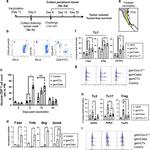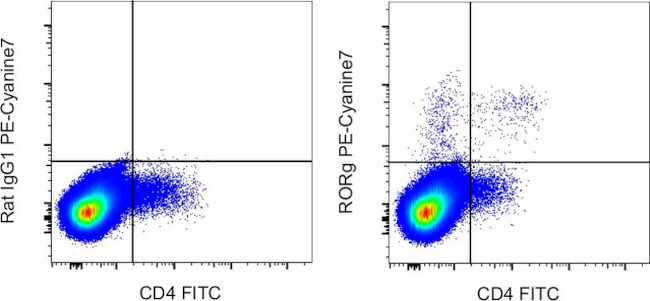Search Thermo Fisher Scientific
Invitrogen
ROR gamma (t) Monoclonal Antibody (B2D), PE-Cyanine7, eBioscience™
FIGURE: 1 / 4
ROR gamma (t) Antibody (25-6981-82) in Flow




Product Details
25-6981-82
Species Reactivity
Published species
Host/Isotype
Recommended Isotype Control
Class
Type
Clone
Conjugate
Excitation/Emission Max
Form
Concentration
Purification
Storage buffer
Contains
Storage conditions
Shipping conditions
RRID
Product Specific Information
Description: The B2D monoclonal antibody reacts with the mouse ROR gamma (t) protein. ROR gamma is a member of the retinoic acid-related orphan receptor (ROR) family, which also includes ROR alpha and ROR beta. ROR family proteins are ligand-dependent transcription factors that play roles in multiple physiological processes. ROR gamma is expressed in several tissues including liver, lung, muscle, heart and kidney. Furthermore, it was discovered that alternative transcription results in the expression of an isoform, ROR gamma t, which is expressed exclusively in cells of the lymphoid compartment, namely CD4+CD8+ "double-positive" thymoyctes, Th17 cells of the periphery and lymphoid tissue inducer (Lti) cells of lymphoid organs.
Applications Reported: This B2D antibody has been reported for use in flow cytometric analysis.
Applications Tested: This B2D antibody has been tested by flow cytometric analysis of mouse thymocytes. This may be used at less than or equal to 0.5 µg per test. A test is defined as the amount (µg) of antibody that will stain a cell sample in a final volume of 100 µL. Cell number should be determined empirically but can range from 10^5 to 10^8 cells/test. It is recommended that the antibody be carefully titrated for optimal performance in the assay of interest.
Light sensitivity: This tandem dye is sensitive to photo-induced oxidation. Please protect this vial and stained samples from light.
Fixation: Samples can be stored in IC Fixation Buffer (Product # 00-8222-49) (100 µL of cell sample + 100 µL of IC Fixation Buffer) or 1-step Fix/Lyse Solution (Product # 00-5333-57) for up to 3 days in the dark at 4°C with minimal impact on brightness and FRET efficiency/compensation. Some generalizations regarding fluorophore performance after fixation can be made, but clone specific performance should be determined empirically.
Excitation: 488-561 nm; Emission: 775 nm; Laser: Blue Laser, Green Laser, Yellow-Green Laser.
Target Information
ROR gamma, a NR1 Thyroid Hormone-Like receptor, has been shown to affect thymopoiesis, bone metabolism, T-cell apoptosis, and lymphoid organogenesis. ROR gamma has been shown to promote thymocyte survival by activating the expression of the antiapoptotic protein Bcl-x(L). ROR gamma is also required for the development of lymph nodes and Peyer's patches. It has been shown that ROR gamma(t), a thymus-specific isoform of ROR gamma from mouse, inhibits Fas ligand expression and cytokine secretion in immature thymocytes. ROR gamma binds as a monomer to response elements composed of a single core motif, GGTCA, preceded by a 6 bp AT-rich sequence. ROR gamma expression has been documented in mouse thymus, adipose, bone, skeletal muscle, liver, and kidney, and in human skeletal muscle. ESTs have been isolated from human tissue libraries, including cancerous head/neck, germ cell, and prostate, and normal colon, head/neck, lung, liver/spleen, and pancreas.
ROR gammat t (RORgt) is an isoform of RORC.
For Research Use Only. Not for use in diagnostic procedures. Not for resale without express authorization.
How to use the Panel Builder
Watch the video to learn how to use the Invitrogen Flow Cytometry Panel Builder to build your next flow cytometry panel in 5 easy steps.
Bioinformatics
Protein Aliases: MGC129539; Nuclear receptor ROR-gamma; Nuclear receptor RZR-gamma; Nuclear receptor subfamily 1 group F member 3; RAR-related orphan receptor C; Retinoid-related orphan receptor-gamma; ROR Gamma; ROR gamma t; RORgt; RP11-98D18.11-001; Thymus orphan receptor; TOR
Gene Aliases: Nr1f3; Rorc; Rorg; RORgamma; Thor; TOR
UniProt ID: (Mouse) P51450
Entrez Gene ID: (Mouse) 19885

Performance Guarantee
If an Invitrogen™ antibody doesn't perform as described on our website or datasheet,we'll replace the product at no cost to you, or provide you with a credit for a future purchase.*
Learn more
We're here to help
Get expert recommendations for common problems or connect directly with an on staff expert for technical assistance related to applications, equipment and general product use.
Contact tech support

